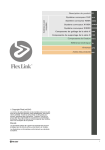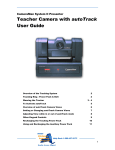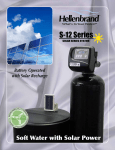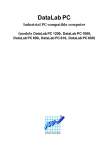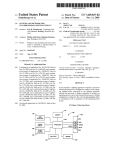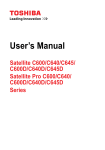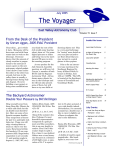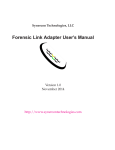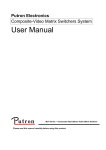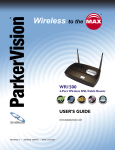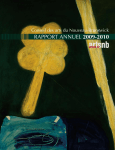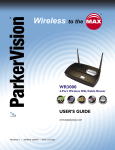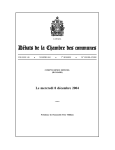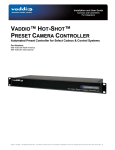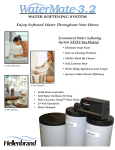Download ETS Classroom Standards - Educational Technology Services
Transcript
AUDIOVISUAL SYSTEMS TECHNOLOGY REPORT PREPARED BY ACENTECH, INC. 24 JUNE 2011 24 JUNE 2011 UCSF AUDIOVISUAL SYSTEMS TECHNOLOGY REPORT TABLE OF CONTENTS 1.0 1.1 1.2 1.3 1.4 1.5 1.6 EXECUTIVE SUMMARY Background Purpose of Report Information Gathering Contributors Facilities Tour Recommendations Summary 1 1 1 1 2 3 4 2.0 2.1 2.2 2.3 2.4 2.5 2.6 2.7 2.8 2.9 DEFINITIONS Infrastructure vs. Equipment Presentation Systems Videoconferencing Systems Course Capture Broadcast Systems Assistive Listening Systems Simultaneous Interpretation Systems Audiovisual Control Systems Remote Management 5 5 5 5 5 5 6 6 6 7 3.0 3.1 3.2 3.3 3.4 3.5 3.6 3.7 3.8 3.9 3.10 3.11 OBSERVATIONS & FINDINGS User Interfaces Lecterns Projectors System Functional Consistency System Design & Integration Consistency Laptop Computer Interfacing Source Devices Classroom Capture Classroom Lighting Acoustics Personnel 8 8 10 11 12 12 12 12 13 13 14 15 4.0 4.1 4.2 4.3 4.4 4.5 4.6 4.7 4.8 4.9 AUDIOVISUAL SYSTEM HIERARCHY Notes and Definitions Drawings Budget Tier I – Small Classroom Tier IIA – Standard Lecture Tier IIB – Standard Lecture + Capture Tier IIIA – VTC Conference Room Tier IIIB – VTC Classroom Tier IV – All other course or client-specific designs: 16 16 16 16 17 18 20 22 24 27 5.0 5.1 5.2 5.3 5.4 SCOPES OF WORK Items and Tasks Furnished by the AV Designer/Consultant Items and Tasks Furnished by the General Contractor Items and Tasks Furnished by the Audiovisual Contractor Items and Tasks Furnished by Others 29 29 29 29 30 ACENTECH PROJECT NO. 621286 PAGE i 24 JUNE 2011 1.0 1.1 UCSF AUDIOVISUAL SYSTEMS TECHNOLOGY REPORT EXECUTIVE SUMMARY Background Acentech is an independent consulting firm specializing in architectural acoustics and the design of advanced sound, audiovisual, multimedia, videoconferencing systems. In order to provide unbiased consulting and design services, Acentech does not sell or install equipment and does not represent any dealer, distributor, or manufacturer of audiovisual or telecommunications equipment. 1.2 1.3 Purpose of Report To provide a baseline assessment of AV technology in spaces maintained by ETS, including video conferencing installations, class capture / videoconferencing systems, user interfaces, projection systems, sound systems, and lighting. To create a written set of AV technology recommendations for upgrades to existing classroom and learning space types for reference by ETS and the UCSF facilities department with future classroom construction / renovation projects, including drawings supporting the above general AV recommendations. This report does not attempt to serve as a general audiovisual systems design guide or training manual. Professional sound, video, control, videoconferencing, and streaming media systems design are complex and broad disciplines, and require extensive study and experience to master. We recommend the following reference guides for education, training, and planning purposes: • InfoComm International, 2003, The Basics of Audio and Visual Systems Design, Revised Edition, Fairfax, VA • InfoComm International, 2007, AV Installation Handbook Second Edition: The Best Practices for Quality Audiovisual Systems, Fairfax, VA • InfoComm International, 2006, Dashboard for Controls Design Guide for the Creation of Touchpanel Control Interfaces and Dashboard for Controls Design Reference, Fairfax, VA • InfoComm International, 2005, The Design & Integration Process for the AV and Construction Industries, Fairfax, VA • Society for College and University Planning, 2000, Technology Driven Planning: Principles to Practice, Ann Arbor, MI • National Institute of Building Sciences, 2008, United States National CAD Standard, Washington, DC Information Gathering This program is based on information, requirements, and issues identified from: UCSF ESAC Strategic Plan - June 2008 UCSF ESAC Report on Education Technology Infrastructure - March 31, 2010 05/16/2011: Parnassus campus classroom tour ETC staff interview meeting TLC and Kanbar tour 05/17/2011: Mission Bay campus tour Mission Bay faculty and staff interview meeting Mt. Zion campus tour 05/18/2011: Parnassus facilities tour Faculty interview meeting Student interview meeting Administrators interview meeting 05/19/2011: Laurel Heights campus tour Various correspondence and e-mail through 6/24/2011. ACENTECH PROJECT NO. 621286 PAGE 1 24 JUNE 2011 1.4 UCSF AUDIOVISUAL SYSTEMS TECHNOLOGY REPORT Contributors The following personnel generously provided their time, comments, expertise, and guidance in the findings of this report: Students Amanda Angelotti Amrit Dosanjh Caroline Linsay Joshua Powers Pan Pan Wong Medicine Medicine Medicine Nursing Medicine Faculty Tina Brock Mark Dellinges Ann Dobson Jeff Kilmer Chandler Mayfield Gail Persily Michael Quirk Kevin Souza Kimberly Topp Brian Waring Kevin Yeung Pharmacy Dentistry Library Nursing Medicine Library Kanbar Center Medicine Physical Therapy Library SIS Administration Heather Alden Jeff Angst Opinder Bawa Joe Castro Elazar Harel David Irby Jon Johnson Helen Loeser Patti Mitchell Dorothy Perry Academic Senate Telemedicine Telemedicine Vice Chancellor CIO Medicine Director of IT for Graduate Division, Mission Bay Medicine Campus Planning Dentistry Educational Technology Services Kyle Van Auker Isaac Conway-Stenzel John DeAngelo Matt Epperson Peter Furlotte Philip Hutchison Henry Kyberg Benjamin Wallen Bret Whittman Video Producer Classroom Support Technician Director Operations Manager Video Conference Coordinator Programmer/Analyst III Assistant Television Engineer Principal Television Producer Assistant Television Engineer ACENTECH PROJECT NO. 621286 PAGE 2 24 JUNE 2011 1.5 UCSF AUDIOVISUAL SYSTEMS TECHNOLOGY REPORT Facilities Tour During the week of April 15, 2011, Acentech toured the Parnassus, Mission Bay, Mt. Zion and Laurel Heights campuses at USCF to assess the current state of Audiovisual (AV) technology currently in use. The tour included over thirty-five learning spaces of various sizes, types, configurations, and age, which represented new construction and major renovation projects, as well as upgrades to legacy systems, and included assessments of the following spaces: 1. 2. 3. 4. Parnassus Campus: ETC Offices, 513 Parnassus Ave. Clinical Sciences Building • C517 & C701 • Anatomy lab (unavailable) Cole Hall • M0156C Auditorium • S214 Classroom Collaborative Learning Environment / CLE • CL 223 & CL 230 • Technology Commons • Lobby • Server Room • SIM Labs Health Sciences West • Auditoria 300, 301, 302, 303 & Core • S159, S160, S161 Seminar Rooms Nursing Building • N225 Lecture Hall, • N729, SB20, SB22 University Hall Building • N417 – Tolland Hall • U456, U460 & U506 • U70 Quiet Room (unavailable) Mission Bay Campus Helen Diller Cancer Research Building • Bakar Auditorium Genentech Building • 106 Byers Auditorium • 114 Wilsey Seminar Room • S202, S204 & S261 Pottruck Auditorium Quantitative Biosciences / QB3 • BH Conference Room 215 • Conference Rooms 211 & 212 Mt. Zion Campus UCSF Medical Center • C106 • Herbst Hall • H3805 (unavailable) Laurel Heights Conference Center • Auditorium ACENTECH PROJECT NO. 621286 PAGE 3 24 JUNE 2011 1.6 UCSF AUDIOVISUAL SYSTEMS TECHNOLOGY REPORT Recommendations Summary The audiovisual systems observed at the four UCSF campuses are of varying age and history, and indicate a wide variety of design approaches, user interfaces, equipment, installation practices, and functionality. In general, our recommendations are to standardize the planning, design, equipment, integration, and maintenance of all UCSF AV assets, regardless of the location, designer or installer. In order to streamline design decisions and standardize AV requirements, a multi-level AV configuration hierarchy is proposed within this report. In order to provide a more uniform user experience and consistent level of expectations, we recommend that all classrooms, seminar and conference rooms with less than 25 seats receive nearly identical systems, including a standardized user interface and functional configuration. We recommend that the design hierarchy be employed in all new projects, as well as upgrades to existing systems. We do not recommend that existing working systems be dismantled solely to conform to the new standard. We recommend that all new systems provide user laptop connectivity for digital video (HDMI, DisplayPort, DVI) as well as legacy analog VGA + audio. We recommend that all new and upgraded AV systems be capable of displaying HD images in widescreen (16:9 or 16:10) image format. In order to reduce technical training and parts inventories, and to streamline service and maintenance, we recommend that major equipment categories (projectors, control systems, routing, mixing, amplification, etc.) be standardized on one major, financially stable manufacturer. To address the trend towards curricular and archival recording of all classroom activities, we recommend that all classrooms and lecture halls over 25 seats be outfitted with electrical infrastructure (conduit, junction boxes, AC power) for future classroom capture / web streaming equipment. We recommend that the design of AV systems be considered and fully integrated early in the design process of any new major renovation or construction project, i.e., during the pre-schematic or schematic design phase. We recommend that ETS be involved early and continuously in the design of any renovation or new construction project where AV systems that ETS may eventually support are planned. We recommend that all ETS employees achieve and maintain InfoComm CTS, CTS-D or CTS-I certifications, as well as manufacturer technical training for the products that they support. We recommend that all major renovation or new construction projects employ the ANSI/ASA 12.60 2010 /Part 1 American National Standard Acoustical Performance Criteria, Design Requirements, and Guidelines for Schools, Part 1: Permanent Schools. We recommend that the ANSI/InfoComm 2M-2010 Standard Guide for Audiovisual Systems Design and Coordination Processes be implemented in all AV systems design and integration projects. We recommend that a written protocol be developed for the design, review, signoff, and ownership of all programming code developed for AV systems at UCSF. This should include Crestron programming code and touch panel layouts, and any custom DSP, routing and switching code developed for AV systems. We recommend that a formal digital archive be deployed for all systems documentation and programming files. We recommend that all new major renovations or new construction projects include a budget for extended preventive maintenance and P&L warranties for AV installations and equipment for up to five years after systems acceptance. We recommend that a schedule of regular cleaning, preventive maintenance, and repair be developed for existing AV systems. We recommend that Crestron RoomView remote management software be expanded to include all AV systems installation under the purview of ETS. ACENTECH PROJECT NO. 621286 PAGE 4 24 JUNE 2011 2.0 2.1 UCSF AUDIOVISUAL SYSTEMS TECHNOLOGY REPORT DEFINITIONS Infrastructure vs. Equipment The distinction between infrastructure and equipment must be emphasized: Infrastructure is part of the building construction and includes conduit, raceways, junction and device boxes, as well as electrical power and grounding specified exclusively for audiovisual systems cabling and equipment. Properly designed AV infrastructure allows for not only the installation of the initially specified equipment, but for the evolution of the systems over many years. If proper infrastructure is provided, additional capabilities and equipment can be added later as technology progresses. Equipment refers to the devices that can be connected through the infrastructure. Equipment includes microphones, loudspeakers, mixers, signal processing gear, video projectors, plasma displays, cameras, playback decks, AV control systems, patch bays, equipment racks, and many other devices that comprise an AV system. One thing is certain – equipment will change over the life of the room as user needs and technology change. For this reason, infrastructure is the key to the long-term success of a thoughtfully conceived AV design project because it governs what can and cannot be easily installed in the future. 2.2 Presentation Systems Presentation systems are the source, routing, and display devices that provide highly intelligible communication of speech, music, information, and graphics to groups of people. This includes equipment such as microphones, loudspeakers, video projectors, flat panel displays, computers, and the interfacing, mixing, routing and control equipment that connects these devices together and allows the user to select the appropriate sources and operate the system. 2.3 Videoconferencing Systems Videoconferencing (VTC) is generally defined at real-time, two-way (symmetric) audio video communications. Video conferencing systems are typically comprised of hardware or software CODECs (coder/ encoders), cameras, microphones, Audio Echo Cancellers (AECs), routing, switching, and display equipment. Professionally designed VTC rooms typically include specialized lighting designed for video, acoustics designed for low background noise and reverberation, and interior finishes that complement compressed video, i.e. light, monochromatic surfaces with little or no patterning. 2.4 Course Capture Course capture is generally defined as a one-way, delayed (asynchronous) audio, video and computer data file that can be archived, edited, and posted to a web streaming server for later viewing. Some course capture devices can stream and record simultaneously, and are therefore considered synchronous devices, however the communications is still one-way, with no ability to communicate in real time with the far end participants. 2.5 Broadcast Systems Broadcast quality equipment and systems generally mean audio and video devices (cameras, video tape recorders and editing equipment) of the highest quality, specifically designed for the recording, editing, and production at the commercial level, such as in network television studios. ACENTECH PROJECT NO. 621286 PAGE 5 24 JUNE 2011 UCSF AUDIOVISUAL SYSTEMS TECHNOLOGY REPORT In general, broadcast quality equipment is an order of magnitude more expensive than “professional” quality equipment, and will be specified for this project only where necessary. 2.6 Assistive Listening Systems Permanently installed Assistive Listening Systems (ALS) are required by the ADA (American with Disabilities Act), a 1990 federal law that forbids discrimination against persons who are handicapped. A 2010 revision states, “In each assembly area where audible communication is integral to the use of the space, an assistive listening system shall be provided” in the following quantities and versions: Receivers for Assistive Listening Systems Capacity of Seating in Assembly Area Minimum Number of Required Receivers Minimum Number of Required Receivers Required to be Hearing-aid Compatible 50 or less 2 2 51 to 200 2, plus 1 per 25 seats over 1 50 seats 2 201 to 500 2, plus 1 per 25 seats over 1 50 seats 1 per 4 receivers1 501 to 1000 20, plus 1 per 33 seats over 1 500 seats 1 per 4 receivers1 1001 to 2000 35, plus 1 per 50 seats over 1 1000 seats 1 per 4 receivers1 2001 and over 55 plus 1 per 100 seats over 1 2000 seats 1 per 4 receivers1 1 Or fraction thereof. The term “assembly area” includes facilities used for entertainment, educational, or civic gatherings. Additionally, courtrooms are required to support Assistive Listening systems regardless of whether or not an installed sound system exists. 2.7 Simultaneous Interpretation Systems Simultaneous interpretation (SI) systems are audio and video equipment that allows group participants speaking different languages to understand and interact with each other in a group through a multilingual interpreter. These systems typically include microphones, audio routing equipment, headsets, receivers, transmitters, and video monitors, as well as one or more sound-isolated booths for the interpreters. 2.8 Audiovisual Control Systems Audiovisual control systems are required to centralize the operation of the various functions of the AV system. This includes environmental controls such as lighting presets and shade and drape controls, as well as audiovisual functions such as system and projector power, source device selection and media transport controls, audio volume controls, and many other operational functions identified by the design team before the equipment is installed. Advanced functions of the AV control system include multi-level password protection for system operation to prevent unauthorized use, control of automatic system shut-down sequences (to reduce unnecessary wear and tear), and a help system interface for user experiencing technical problems (see below). ACENTECH PROJECT NO. 621286 PAGE 6 24 JUNE 2011 2.9 UCSF AUDIOVISUAL SYSTEMS TECHNOLOGY REPORT Remote Management TM TM Crestron e-Control and RoomView are network-based software systems that allow the monitoring and remote operation of AV systems via the campus LAN and the Internet. These systems allow technical personnel to operate audiovisual systems in remote locations from any computer with a web browser and an authorized password. Custom programming is required to create the user interface web pages, and to configure and implement this software. The features of remote management systems include: Real-time monitoring of system status, including notification of imminent problems in certain devices such as projectors, before they fail. A help system for users, with immediate response and feedback capability through the Touch Panels. A method of asset management by tracking equipment usage in real time. ACENTECH PROJECT NO. 621286 PAGE 7 24 JUNE 2011 3.0 3.1 UCSF AUDIOVISUAL SYSTEMS TECHNOLOGY REPORT OBSERVATIONS & FINDINGS User Interfaces The most striking and concerning aspect of the tour was the disparity of user interface controllers which ranged from sophisticated touch-screens to small push button control panels with dissimilar operational and nomenclature consistency. ADDENDUM 1 attached to this report is a documentation sample of a typical professional AV control checklist, programming timeline, process flowchart, specification signoff sheet, and user manual. Additional resources and full versions of the samples can be downloaded from: http://www.controlconcepts.net/resources/ (courtesy Control Concepts, Inc., Fair Lawn, NJ). Below are a few examples of the various user interfaces currently in use at UCSF: Parnassus Campus, Cole Hall: Parnassus, CLE SIM Lab: Parnassus Campus, Tolland Hall: Mission Bay, Bakar Auditorium: ACENTECH PROJECT NO. 621286 PAGE 8 24 JUNE 2011 UCSF AUDIOVISUAL SYSTEMS TECHNOLOGY REPORT Parnassus Campus, CLE: Mission Bay, Wilsey Seminar Room: Parnassus Campus, Health Sciences West: Mission Bay, QB3 Conference Room 211: Parnassus Campus, Nursing SB22: Mission Bay, S202: ACENTECH PROJECT NO. 621286 PAGE 9 24 JUNE 2011 3.2 UCSF AUDIOVISUAL SYSTEMS TECHNOLOGY REPORT Lecterns We also observed an apparent disparity between lectern millwork designs. This may reflect the lack of a current campus standard for lecterns and/or the influence of various millworkers and architects on different projects at different time periods: Inconsistent lectern designs impose varying ergonomic configurations and therefore dissimilar user controls, display monitors, and ultimately, AV systems design and support: Parnassus Campus, C701: Parnassus, N225 Lecture Hall: Laurel Heights S21 Auditorium: Parnassus Campus, M0156C Auditorium: ACENTECH PROJECT NO. 621286 PAGE 10 24 JUNE 2011 N217 Tolland Hall: 3.3 UCSF AUDIOVISUAL SYSTEMS TECHNOLOGY REPORT Herbst Hall: Projectors With some exceptions, we observed the use of Panasonic video projectors throughout the campus. Projector and display consistency allows ETS to maintain a supply of replacement projectors that can be swapped out, as well as a limited inventory of replacement lamps and parts. Other advantages are streamlined repair protocols, bulk pricing and manufacturer rebates. This methodology should be continued. Clinical Sciences C17: University Hall U506: Nursing N225 lecture Hall Pottruck Auditorium: ACENTECH PROJECT NO. 621286 PAGE 11 24 JUNE 2011 3.4 UCSF AUDIOVISUAL SYSTEMS TECHNOLOGY REPORT System Functional Consistency Another notable concern was the apparent lack of system functional consistency, particularly for simple classroom design. There are many factors that contribute to inconsistent design, including specific user requirements, technology obsolescence, different designers and installers, architectural / room shape constraints, design work flow, and conflicting project requirements. We recommend that a UCSF Campus Classroom Design Standard be established as a template for several typical learning space types. The standard can be applied to major and minor renovations as well and any new projects to assist with streamlining the design process, guiding architects, consultants and AV designers, and reducing time-consuming design charrettes. The standard can be applied whether the systems are designed and built by UCSF personnel, a professional integrator, or by a consultant as part of a major construction project. 3.5 System Design & Integration Consistency We recommend that the AV design protocol be standardized using the ANSI-InfoComm Standard Guide for Audiovisual Systems Design and Coordination 2M-2010 as an outline, downloadable at this address: http://webstore.ansi.org/RecordDetail.aspx?sku=ANSI%2FINFOCOMM+2M-2010 We also recommend the purchase of the companion Audiovisual Systems Documentation Sample, downloadable at this address: http://webstore.ansi.org/RecordDetail.aspx?sku=Icedu-DOCSMPL09 These documents outline and provide industry-accepted samples of the consistent, chronological, and essential steps and documentation required to manage the design process through all phases of the audiovisual design and installation process. 3.6 Laptop Computer Interfacing In December of 2010, AMD, Dell, Intel, Lenovo, Samsung LG announced that analog VGA outputs on laptops and PCs will no longer be available by 2015. AMD plans to start removing VGA and DVI-I outputs from its computer output chipsets in 2013. The new output and connectivity standard will likely be (digital) DisplayPort 1.2 and HDMI 1.4a. http://www.slashgear.com/vga-dead-by-2015-say-intel-amd-pcdisplay-makers-09118507/ During our tour we observed that most of the learning spaces did not support direct input of HDMI, DVI-D or DisplayPort. We recommend that digital interfacing and widescreen display, monitoring, and routing be provided in all new learning space AV system designs. 3.7 Source Devices With the rapid proliferation of laptops, net books, tablet PCs, iPads etc., and the migration toward digital audio and video playback, we recommend minimal use of stand-alone source devices such as video document camera and VCR / CD / DVD, and Bluray playback decks. These devices are quickly outdated, and most modern personal computing devices have software or hardware media players built in. In addition, the “analog sunset” (a provision that restricts the output of decrypted analog video output on Bluray disc players) will take full effect on 1 January 2014: http://media.extron.com/download/files/whitepaper/analog_sunset.pdf In small classrooms, we recommend the elimination of stand-alone playback devices altogether to reduce equipment costs for design, installation, maintenance, support, repair, and replacement. We recommend ACENTECH PROJECT NO. 621286 PAGE 12 24 JUNE 2011 UCSF AUDIOVISUAL SYSTEMS TECHNOLOGY REPORT that small classrooms include connectivity for portable VGA and digital source devices (HDMI, DisplayPort, DVI, etc.), and simplified controls for display power, input select and volume control only. We do not fully agree with paragraph 2.1.7 Technology-enabled Classrooms from the 2008 ESAC Strategic Plan: “Classroom Capture Technology-enabled classrooms require, at a minimum, computers and projection, smart podiums, projection screens that are also white boards, digital ink, document cameras, wireless access, and audience response systems They often require that student have laptops with appropriate software for use in collaboration exercises, and therefore have extensive power outlet availability” With the exception of large-screen projection, wireless access, and adequate power outlets for laptops, the current trend in small classroom design is away from extensive installed source equipment. Audience response systems are relatively inexpensive and can be deployed on an as-needed basis and should not be automatically provided in every classroom. It is our position that in a few short years, all playback media will be digital playback media and the need for dedicated local playback devices will be entirely eclipsed by mobile computing devices. In addition, the requirement for dedicated computers in small classrooms is an expensive and significantly laborintensive model to support. 3.8 Classroom Capture We understand that UCSF is considering standardizing on Echo360 or Tandberg for classroom capture for web streaming and archival purposes. At InfoComm 2011 in June, Crestron announced the CAPTURE-HD ($3,800 MSRP) and CAPTURE-HD-PRO ($5,800 MSRP) - new entries in the classroom capture market that hold some promise for relatively affordable, easily integrated classroom recording and streaming . The expected availability of these models is October, 2011. We expect the demand for classroom capture to grow rapidly and that any new or renovated teaching space with more than 25 seats should be outfitted with infrastructure to support classroom capture, including conduit and electrical infrastructure for an AV equipment rack, one or more PTZ cameras, instructor and audience microphones, and lighting designed for video. However, the equipment need not be installed until the curricular need or user demand is conclusive. 3.9 Classroom Lighting Modern classroom design typically has a front wall with both writing surfaces and projection or display surfaces. Lighting should be designed to allow for multiple “scenes”, including dimmable general room lighting and independent zones to illuminate or darken the front wall by section to allow combinations of light on writing surfaces and no light on projection and display surfaces. Small classrooms should include manual dimming sliders with separately zoned circuits for front-of-room and/or projection wall lighting. Further zoning may be required where presentation walls have a combination of writing and projection or display surfaces. Connection to the AV system is not necessary in small classrooms. Large classrooms and lecture halls should include dimmer packs and programmable lighting with RS-232 interfaces for connection to the AV control system. The AV control systems should provide the user with no more than 5 or 6 lighting presets, typically configured as ALL OFF, ALL ON, PROJECTION, NOTE TAKING, VIDEO, and perhaps a special case preset. More than 6 presets are confusing to the user, ACENTECH PROJECT NO. 621286 PAGE 13 24 JUNE 2011 UCSF AUDIOVISUAL SYSTEMS TECHNOLOGY REPORT although a separate technician lighting control page may be desirable in an environment where lighting is unusually sophisticated, or where certain light should not be accessible by users, such as a video broadcast studio, theatrical venue, or large videoconferencing venue. For rooms that will be used for video recording such as course capture and videoconferencing, the following general guidelines should be followed: Do not use dark, patterned, or reflective finish materials, including millwork, tables, and chairs. Contrast ratio - environment to people: front wall = 4-5:1, side/back walls = 3-4:1 Keep the ceiling finishes light, especially when using an indirect lighting solution. For videoconferencing, design for 45-75 footcandles. For course capture, design for 40-55 footcandles. Use high color rendering fluorescent luminaires at minimum 3,500 Kelvin color temperature. Halogen or incandescent point source luminaires should be avoided. Any windows, clerestories, or skylights should have 100% light blocking shades in addition to any room darkening shades provided. 3.10 Acoustics A recurring issue was the difficulty in achieving acceptable intelligibility of speech audio for video conferencing, video streaming, and archival recording. Many of the learning spaces visited exhibited high background and adjacency noise levels due to loud HVAC systems, street traffic, and lack of properly isolated doors and windows. In addition, many rooms lacked interior acoustic treatment to reduce speech reverberation. We recommend that USCF adopt the ANSI/ASA S12.60-2010/Part 1 American National Standard Acoustical Performance Criteria, Design Requirements, and Guidelines for Schools, Part 1: Permanent Schools, as an architectural requirement for all new projects, downloadable at this Acoustical Society of America website: http://asastore.aip.org In general, we recommend the following guidelines be followed: 1. 35dBA (or NC-30 equivalent) maximum background sound level (per ANSI 12.60 2010) in small classrooms where regular audio or audio/video recording is not expected. 2. 30dBA (or NC-25 equivalent) maximum background sound level (better than ANSI 12.60 2010) in lecture halls, auditoria, conference, seminar and meeting rooms where regular audio or audio/video recording is expected. 3. RT60 (Reverberation Time) of less than 0.6 seconds (per ANSI S12.60 2010) 4. For noise isolation requirements refer to ANSI 12.60 2010, section 5.4. ACENTECH PROJECT NO. 621286 PAGE 14 24 JUNE 2011 UCSF AUDIOVISUAL SYSTEMS TECHNOLOGY REPORT 3.11 Personnel We were pleased to observe the technical depth and diversity in the current Technology Services staff including specialists in networking, classroom capture, AV system design, Crestron programming and touch panel design, instructional support, help desk support, troubleshooting, maintenance, & repair, and system installation were evident. We recommend that this foundation be strengthened and expanded with additional training and certification from InfoComm, Crestron, Extron, Tandberg, ClearOne, and other major manufactures. As a non-manufacturer specific technical foundation, we recommend the InfoComm CTS Program: http://www.infocomm.org/cps/rde/xchg/infocomm/hs.xsl/7009.htm We recommend that designers and programmers achieve the InfoComm CTS-D certification: http://www.infocomm.org/cps/rde/xbcr/infocomm/CERT_Handbook_CTS-D.pdf We recommend that field support and service technicians achieve the InfoComm CTS-I certification: http://www.infocomm.org/cps/rde/xbcr/infocomm/CERT_Handbook_CTS-I.pdf We recommend that all other personnel on the Technology Services Staff achieve InfoComm CTS certification: http://www.infocomm.org/cps/rde/xbcr/infocomm/Cert_Handbook_CTS.pdf Additional recommended manufacturer certifications include: Crestron: http://www.crestron.com/training Extron: http://www.extron.com/training/index.aspx Tandberg: http://www.telepresenceu.com/course/category.php?id=0&type=all ClearOne: http://www.clearone.com/resources/training.php?content=product ACENTECH PROJECT NO. 621286 PAGE 15 24 JUNE 2011 4.0 4.1 UCSF AUDIOVISUAL SYSTEMS TECHNOLOGY REPORT AUDIOVISUAL SYSTEM HIERARCHY Notes and Definitions The following outline is not a technical specification and is insufficient to design, bid, or build an AV system. Except where useful to illustrate a standard of performance or a specific campus standard, equipment manufacturers and model numbers are not used. Permanently installed refers to equipment that is part of the room systems and cannot easily be removed for use elsewhere. Portable refers to equipment that is available for connection at one or more locations, but is not hardwired to the system. Portable equipment can be disconnected by the user or technical personnel and stored or used with systems elsewhere in the facility. Future Provisions refers to equipment that may be purchased and used or installed at a future date. OFE (Owner Furnished Equipment) refers to equipment that is either already owned by UCSF, or may be purchased in the future as needs arise. The terms CFE (Client Furnished Equipment) and FBO (Furnished by Owner or Others) are common equivalent abbreviations. 4.2 Drawings ADDENDUM 2 attached to this report includes schematic drawings produced to indicate the general design of the systems outlined in the hierarchy. These drawings indicate the general connectivity and relationship of equipment within the system, but do not represent a complete design, and do not represent any particular space at UCSF. The drawings are provided as a general guide for the designer and must be vetted against the actual programmatic requirements, equipment models selected, architectural attributes, and many other technical specifics of the design and integration of the AV systems. 4.3 Budget The equipment lists provided follow the general design of the systems outlined in the hierarchy. The lists are provided for budgeting purposes, and reflect a general level of systems design. The presence or absence of accessory items is not definitive and must be reviewed and adjusted before design and bid documents are finalized. The individual and sectional prices listed in the budget estimates represent manufacturer suggested retail prices (MSRP) and include installation labor costs. These figures assume that equipment will be priced at a discount from list price, and incorporates the costs associated with engineering, installation, documentation, training, and on-site maintenance for one year. The greatest variable is installation cost which is dependent on factors such as site conditions, divisions of work between audiovisual and other subcontractors, local market conditions, and project requirements for union labor. These estimates assume that union labor will be required for on-site installation work during major building construction projects. ACENTECH PROJECT NO. 621286 PAGE 16 24 JUNE 2011 4.4 UCSF AUDIOVISUAL SYSTEMS TECHNOLOGY REPORT Tier I – Small Classroom 1. General room attributes a. Approximately 25 seats or less b. Manual lighting control c. Manual pull-down screen or manually operated motorized screen control d. Manually controlled shades and drapes (if applicable) e. No permanently installed computer, equipment racks or source equipment f. Ceramic whiteboards (no vinyl or laminates) g. Permanently mounted AV system operation instruction and help desk signage 2. Electrical infrastructure to support the AV system, including: a. Conduit, junction boxes, stub-ups and pull strings to support the AV system including but not limited to the display, projector, wall and floor boxes, as applicable b. All conduit to be rigid metallic type, no PVC c. All AV power on same phase d. Wired data receptacles as needed e. Scrub water approved AV floor boxes with adjustable internal brackets, separate access and cable exit hatches and rubber gadgets (FSR FL-500P-6 or FL-600P-6) f. Blocking and structural support provided for projection screens, projectors, displays, loudspeakers, cameras and other surface-mounted devices per California State and local seismic building codes. g. Dimmable lighting zoned for presentations (separately switchable zone at display wall) h. Adequate AC power receptacles for all student laptops with minimal trip hazards i. Adequate wireless UCSF LAN/Internet access 3. Acoustical Requirements: a. 35dBA (or NC-30 equivalent) maximum background sound level (per ANSI 12.60 2010) b. RT60 of less than 0.6 seconds (per ANSI S12.60 2010) c. For noise isolation requirements refer to ANSI 12.60 2010, section 5.4. 4. Single HD Display (Flat Panel or Front Projection) with: a. Junction box and conduit to control panel and input receptacle b. Ethernet connectivity for Crestron RoomView c. Minimum native resolution: 1,280 x 800 pixels d. Maximum scaled resolution: 1,920 x 1,200 pixels e. Wall-mounted stereo playback loudspeakers for video projectors; internal or add-on playback loudspeakers for flat panel displays. f. Theft security (projector cage, lockable mount / cable with Wobble detector) 5. Wall or Table-mounted wired control panel (Crestron MPC-M10) with: a. Projector on/off b. Input select c. Volume control 6. Wall or table-mounted wired laptop connectivity with a. DisplayPort / HDMI laptop input b. VGA + Audio legacy input c. Duplex AC power receptacle d. Wired Ethernet receptacle 7. No speech support microphones or loudspeakers ACENTECH PROJECT NO. 621286 PAGE 17 24 JUNE 2011 4.5 UCSF AUDIOVISUAL SYSTEMS TECHNOLOGY REPORT Tier IIA – Standard Lecture 1. General room attributes: a. Generally greater than 25 seats b. Motorized projection screen with low-voltage interface and 3-button wall control c. Manual or motorized shade/drape controls as applicable d. Interior finishes appropriate for video recording (no patterned or dark backgrounds) e. Instructor lectern with: i. Wired gooseneck microphone ii. Dimmable LED reading lamp (Littlelite L18 or similar) iii. Tilt-mount wired LCD touch panel. iv. HDMI laptop input v. VGA + Audio laptop input vi. Duplex power receptacle vii. Wired Ethernet receptacle and viii. Dedicated room computer ix. Other equipment and accessories specified by the University f. Ceramic whiteboards (no vinyl or laminates) g. Permanently mounted AV system operation instruction and help desk signage 2. Electrical infrastructure to support the AV system, including: a. Conduit, junction boxes, stub-ups and pull strings to support the AV system including but not limited to the AV rack, lectern, displays, projection screens, lighting dimmers and shade motors, as applicable b. All conduit and junction boxes to be rigid metallic type, no PVC or plastic c. All AV power on same phase d. Wired data receptacles as needed e. Scrub water approved AV floor boxes with adjustable internal brackets, separate access and cable exit hatches and rubber gadgets (FSR FL-500P-6 or FL-600P-6) f. Blocking and structural support provided for projection screens, projectors, displays, loudspeakers, cameras and other surface-mounted devices per California State and local seismic building codes. g. Dimmable lighting zoned for presentations (separately switchable zone(s) at display wall) h. Adequate AC power receptacles for all student laptops with minimal trip hazards i. Adequate wireless UCSF LAN/Internet access 3. Acoustical Requirements: a. 35dBA (or NC-30 equivalent) maximum background sound level (per ANSI 12.60 2010) b. RT60 of less than 0.6 seconds (per ANSI S12.60 2010) c. For noise isolation requirements refer to ANSI 12.60 2010, section 5.4. 4. Single or dual HD Display (Flat Panel or Front Projection) with: a. Minimum native resolution 1,280 x 800 b. Maximum scaled resolution – 1,920 x 1,200 c. Theft security (projector cage, lockable mount / cable with Wobble detector) 5. Instructor Speech Support: a. Minimum two channel wireless lapel microphone system (true diversity, frequency agile type (Shure UHF-R or similar) b. Flush-mount ceiling loudspeakers to amplify instructor speech c. ADA-compliant Assistive Listening System (ALS) ACENTECH PROJECT NO. 621286 PAGE 18 24 JUNE 2011 UCSF AUDIOVISUAL SYSTEMS TECHNOLOGY REPORT 6. Tilt-mount wired 6” LCD touch panel (Crestron TPS-6 or similar) with: a. Standard UCSF branding & color scheme b. UCSF standard logical, intuitive controls c. Crestron e-Control if requested by ETS d. Password protection/levels: i. User (students & guests) ii. Advanced User (faculty) iii. Technician e. Environment controls i. Projection screen(s) up/down ii. Lighting presets iii. Shade/drape control (if applicable) f. System on/off g. Input select h. Source transport control, if applicable i. Volume control 7. Equipment rack including: a. Adequate service access (30” OSHA minimum) b. Ventilation – convection/passive preferred, fan if necessary c. Physical security (star-post rack bolts, locking door, etc.) d. Control, routing, interfacing, processing, and amplification equipment e. Ethernet connectivity for Crestron RoomView f. Balanced line level input and output to connect portable equipment g. Surge protector with power sequencing to turn audio amplifier(s) on last / off first. h. System installation information i. Date of installation (month/year) ii. Designer (UC/consultant/contractor) iii. Installer (UC or contractor) iv. Service support contact information ACENTECH PROJECT NO. 621286 PAGE 19 24 JUNE 2011 4.6 UCSF AUDIOVISUAL SYSTEMS TECHNOLOGY REPORT Tier IIB – Standard Lecture + Capture 1. General room attributes: a. Generally greater than 25 seats b. Dimmable, zoned lighting appropriate for video recording - high color rendering fluorescent, 3500 Kelvin or higher c. Motorized projection screen with low-voltage interface and 3-button wall control d. Manual or motorized shade/drape controls as applicable e. 100% light control of any exterior windows f. Interior finishes appropriate for video recording (no patterned or dark backgrounds) g. Instructor lectern with: i. Wired gooseneck microphone ii. Dimmable LED reading lamp (Littlelite L18 or similar) iii. Tilt-mount wired LCD touch panel. iv. HDMI laptop input v. VGA + Audio laptop input vi. Duplex power receptacle vii. Wired Ethernet receptacle and viii. Dedicated room computer ix. AV touch panel controller x. Other equipment and accessories specified by the University. h. Ceramic whiteboards (no vinyl or laminates) i. Permanently mounted AV system operation instruction and help desk signage 2. Electrical infrastructure to support the AV system, including: a. Conduit, junction boxes, stub-ups and pull strings to support the AV system including but not limited to the AV rack, lectern, displays, projection screens, lighting dimmers and shade motors, as applicable b. All conduit and junction boxes to be rigid metallic type, no PVC or plastic c. All AV power on same phase d. Wired data receptacles as needed e. Scrub water approved AV floor boxes with adjustable internal brackets, separate access and cable exit hatches and rubber gadgets (FSR FL-500P-6 or FL-600P-6) f. Blocking and structural support provided for projection screens, projectors, displays, loudspeakers, cameras and other surface-mounted devices per California State and local seismic building codes. g. Dimmable lighting zoned for presentations (separately switchable zone(s) at display wall) h. Adequate AC power receptacles for all student laptops with minimal trip hazards i. Adequate wireless UCSF LAN/Internet access 3. Acoustical Requirements: a. 30dBA (or NC-25 equivalent) maximum background sound level (better than ANSI 12.60 2010) b. RT60 of less than 0.6 seconds (per ANSI S12.60 2010) c. For noise isolation requirements refer to ANSI 12.60 2010, section 5.4. 4. Course capture equipment including: a. Rack-mount HD course capture device (1080p, H.264 file format) with: i. Uninterruptable power supply (UPS) ii. Dedicated Ethernet data drop b. One P/T/Z video camera aimed at front wall / instructor c. Minimum 8-channel automatic microphone mixer with priority override, noise cancellation and adaptive noise filtering (ClearOne Converge Pro 880 or similar) d. Ceiling microphones to pick up audience speech e. Control panel page to include course capture record, pause, & stop controls f. Wall-mounted “On-Air” indicators clearly visible by all participants within the room. ACENTECH PROJECT NO. 621286 PAGE 20 24 JUNE 2011 UCSF AUDIOVISUAL SYSTEMS TECHNOLOGY REPORT g. Large digital LED clock visible by all participants 5. Large single or dual HD displays (flat panel or front projection) with: a. Minimum native resolution 1,280 x 800 b. Minimum scaled resolution – 1,920 x 1,200 c. Theft security (projector cage, lockable mount / cable with Wobble detector) 6. Instructor Speech Support: a. Minimum two channel wireless lapel microphone system (true diversity, frequency agile type (Shure UHF-R or similar) b. Flush-mount ceiling loudspeakers to amplify instructor speech c. ADA-compliant Assistive Listening System (ALS) 7. Tilt-mount wired 6” LCD touch panel (Crestron TPS-6 or similar) with: a. Standard UCSF branding & color scheme b. UCSF standard logical, intuitive controls c. Crestron e-Control if requested by ETS d. Password protection/levels: i. User (students & guests) ii. Advanced User (faculty) iii. Technician e. Environment controls i. Projection screen(s) up/down ii. Lighting presets iii. Shade/drape control (if applicable) f. System on/off g. Input select h. Source transport control, if applicable i. Volume control 8. Equipment rack including: a. Adequate service access (30” OSHA minimum) b. Ventilation – convection/passive preferred, fan if necessary c. Physical security (star-post rack bolts, locking door, etc.) d. Control, routing, interfacing, processing, and amplification equipment e. Ethernet connectivity for Crestron RoomView f. Balanced line level input and output to connect portable equipment g. Surge protector with power sequencing to turn audio amplifier(s) on last / off first. h. System installation information i. Date of installation (month/year) ii. Designer (UC/consultant/contractor) iii. Installer (UC or contractor) iv. Service support contact information ACENTECH PROJECT NO. 621286 PAGE 21 24 JUNE 2011 4.7 UCSF AUDIOVISUAL SYSTEMS TECHNOLOGY REPORT Tier IIIA – VTC Conference Room 1. General room attributes: a. Generally less than 25 seats b. Dimmable, zoned lighting appropriate for video recording - high color rendering fluorescent, 3500 Kelvin or higher c. Manual or motorized shade/drape controls as applicable d. 100% light control of any exterior windows e. Interior finishes appropriate for video recording (no patterned or dark backgrounds) f. Table-mounted wired laptop connectivity and AV control with: i. HDMI input ii. VGA + Audio iii. Adequate AC power receptacles for all table seats iv. Wired Ethernet receptacle for all table seats v. Dedicated room computer vi. Tilt-mount wired LCD touch panel. g. No permanently installed Assistive Listening System; portable ALS connections are included below. h. Permanently mounted AV system operation instruction and help desk signage 2. Electrical infrastructure to support the AV system, including: a. Conduit, junction boxes, stub-ups and pull strings to support the AV system including but not limited to the AV rack, displays, projectors, lighting dimmers and shade motors, as applicable b. All conduit to be rigid metallic type, no PVC c. All AV power on same phase d. Wired data receptacles as needed e. Scrub water approved AV floor boxes with adjustable internal brackets, separate access and cable exit hatches and rubber gadgets (FSR FL-500P-6 or FL-600P-6) f. Blocking and structural support provided for projection screens, projectors, displays, loudspeakers, cameras and other surface-mounted devices per California State and local seismic building codes. g. Dimmable lighting zoned for presentations (separately switchable zone(s) at display wall) h. Adequate AC power receptacles for all student laptops with minimal trip hazards i. Adequate wireless UCSF LAN/Internet access 3. Acoustical Requirements: a. 30dBA (or NC-25 equivalent) maximum background sound level (better than ANSI 12.60 2010) b. RT60 of less than 0.6 seconds (per ANSI S12.60 2010) c. For noise isolation requirements refer to ANSI 12.60 2010, section 5.4. 4. HD video conferencing system with: a. Rack-mount HD CODEC with: i. Multisite capabilities ii. Dual HD video output capable of simultaneous local presentation content and far end video (Tandberg NPP or similar) iii. Far-end camera control iv. High Ethernet bandwidth (rate specified by the University) v. Telephone interface (ClearOne Converge Pro TH20 or similar) vi. Uninterruptable power supply (UPS) vii. Dedicated Ethernet data drops b. Minimum two HD P/T/Z video cameras covering: i. Seated near site participants ii. Overhead documents on table or vertical writing surface ACENTECH PROJECT NO. 621286 PAGE 22 24 JUNE 2011 UCSF AUDIOVISUAL SYSTEMS TECHNOLOGY REPORT c. Minimum 8-channel automatic microphone mixer with priority override, noise cancellation and adaptive noise filtering (ClearOne Converge Pro 880 or similar) d. Table mounted boundary microphones e. Multi-channel Audio Echo Cancellation (AEC) f. Control panel page to include call initiation / termination, telephone add-on, multisite, monitor configuration and other controls as specified by the University. g. Wall-mounted “On-Air” indicators clearly visible by all participants within the room. h. Large digital LED clock visible by all participants 5. Dual or large single display (flat panel or rear projection) with: a. Minimum native resolution 1,280 x 800 b. Maximum scaled resolution – 1,920 x 1,200 c. Theft security (projector cage, lockable mount / cable with Wobble detector) 6. Wired tilt-mount 12” LCD touch panel (Crestron TPMC-12) at table with: a. Standard UCSF branding & color scheme b. UCSF standard logical, intuitive controls c. Crestron e-Control if requested by ETS d. Password protection/levels: i. User (students & guests) ii. Advanced User (faculty) iii. Technician e. Environment controls i. Projection screen(s) up/down ii. Lighting presets iii. Shade/drape control (if applicable) f. System on/off g. Input select h. Source transport control, if applicable i. Volume control j. VTC controls (call initiation, termination, camera presets, etc.) 9. Equipment rack including: a. Adequate service access (30” OSHA minimum) b. Ventilation – convection/passive preferred, fan if necessary c. Physical security (star-post rack bolts, locking door, etc.) d. Control, routing, interfacing, processing, and amplification equipment e. Ethernet connectivity for Crestron RoomView f. Balanced line level input and output to connect portable equipment g. Surge protector with power sequencing to turn audio amplifier(s) on last / off first. h. System installation information i. Date of installation (month/year) ii. Designer (UC/consultant/contractor) iii. Installer (UC or contractor) iv. Service support contact information ACENTECH PROJECT NO. 621286 PAGE 23 24 JUNE 2011 4.8 UCSF AUDIOVISUAL SYSTEMS TECHNOLOGY REPORT Tier IIIB – VTC Classroom 1. General room attributes: a. Generally greater than 25 seats b. Dimmable, zoned lighting appropriate for video recording - high color rendering fluorescent, 3500 Kelvin or higher c. Motorized projection screen with low-voltage interface and 3-button wall control d. Manual or motorized shade/drape controls as applicable e. 100% light control of any exterior windows f. Interior finishes appropriate for video recording (no patterned or dark backgrounds) g. Instructor lectern with: i. Wired gooseneck microphone ii. Dimmable LED reading lamp (Littlelite L18 or similar) iii. Tilt-mount wired LCD touch panel with preview windowing iv. HDMI laptop input v. VGA + Audio laptop input vi. Duplex power receptacle vii. Wired Ethernet receptacle viii. Dedicated room computer ix. AV touch panel controller x. Other equipment and accessories specified by the University. h. Ceramic whiteboards (no vinyl or laminates) i. Permanently mounted AV system operation instruction and help desk signage 2. Electrical infrastructure to support the AV system, including: a. Conduit, junction boxes, stub-ups and pull strings to support the AV system including but not limited to the AV rack, lectern, displays, projection screens, lighting dimmers and shade motors, as applicable b. All conduit to be rigid metallic type, no PVC c. All AV power on same phase d. Wired data receptacles as needed e. Scrub water approved AV floor boxes with adjustable internal brackets, separate access and cable exit hatches and rubber gadgets (FSR FL-500P-6 or FL-600P-6) f. Blocking and structural support provided for projection screens, projectors, displays, loudspeakers, cameras and other surface-mounted devices per California State and local seismic building codes. g. Dimmable lighting zoned for presentations (separately switchable zone(s) at display wall) h. Adequate AC power receptacles for all student laptops with minimal trip hazards i. Adequate wireless UCSF LAN/Internet access 3. Acoustical Requirements: a. 30dBA (or NC-25 equivalent) maximum background sound level (better than ANSI 12.60 2010) b. RT60 of less than 0.6 seconds (per ANSI S12.60 2010) c. For noise isolation requirements refer to ANSI 12.60 2010, section 5.4. 4. HD video conferencing system with: a. Rack-mount HD CODEC with: i. Multisite capabilities ii. Dual HD video output capable of simultaneous local presentation content and far end video (Tandberg NPP or similar) iii. Far-end camera control iv. High Ethernet bandwidth (rate specified by the University) v. Telephone interface (ClearOne Converge Pro TH20 or similar) vi. Uninterruptable power supply (UPS) vii. Dedicated Ethernet data drops b. Minimum two (2) HD P/T/Z video cameras covering: ACENTECH PROJECT NO. 621286 PAGE 24 24 JUNE 2011 5. 6. 7. 8. 9. 10. UCSF AUDIOVISUAL SYSTEMS TECHNOLOGY REPORT i. Instructor lectern and entire front wall or stage area ii. Audience c. Minimum 8-channel automatic microphone mixer with priority override, noise cancellation and adaptive noise filtering (ClearOne Converge Pro 880 or similar) d. Ceiling microphones to pick up audience speech or desk-mounted audience microphones where fixed tables are used e. Multi-channel Audio Echo Cancellation (AEC) f. Control panel page to include course capture record, pause, & stop controls g. Wall-mounted “On-Air” indicators clearly visible by all participants within the room. h. Large digital LED clock visible by all participants Large dual HD displays (flat panel or front projection) with: a. Minimum native resolution 1,280 x 800 b. Minimum scaled resolution – 1,920 x 1,200 c. Theft security (projector cage, lockable mount / cable with Wobble detector) Large flat-panel instructor confidence monitors, with the following attributes: a. Quantity to match front wall displays b. Clear sightlines for standing instructor (not blocked by standing or seated participants) c. Co-located with instructor camera d. Video routing to duplicate front wall displays Instructor Speech Support: a. Minimum two channel wireless lapel microphone system (true diversity, frequency agile type (Shure UHF-R or similar) b. Flush-mount ceiling loudspeakers to amplify instructor speech c. ADA-compliant Assistive Listening System (ALS) Wired tilt-mount 15” LCD touch panel at lectern with: a. Preview windowing b. Standard UCSF branding & color scheme c. UCSF standard logical, intuitive controls d. Crestron e-Control if requested by ETS e. Password protection/levels: i. User (students & guests) ii. Advanced User (faculty) iii. Technician f. Environment controls i. Projection screen(s) up/down ii. Lighting presets iii. Shade/drape control (if applicable) g. System on/off h. Input select i. Source transport control, if applicable j. Volume control Wall or table-mounted wired laptop connectivity with a. HDMI input b. VGA + Audio c. Duplex AC power receptacle d. Wired Ethernet receptacle Equipment rack including: a. Adequate service access (30” OSHA minimum) b. Ventilation – convection/passive preferred, fan if necessary c. Physical security (star-post rack bolts, locking door, etc.) d. Control, routing, interfacing, processing, and amplification equipment e. Balanced line level input and output to connect portable equipment f. Surge protector with power sequencing to turn audio amplifier(s) on last / off first. ACENTECH PROJECT NO. 621286 PAGE 25 24 JUNE 2011 g. System i. ii. iii. iv. UCSF AUDIOVISUAL SYSTEMS TECHNOLOGY REPORT installation information Date of installation (month/year) Designer (UC/consultant/contractor) Installer (UC or contractor) Service support contact information ACENTECH PROJECT NO. 621286 PAGE 26 24 JUNE 2011 4.9 UCSF AUDIOVISUAL SYSTEMS TECHNOLOGY REPORT Tier IV – All other course or client-specific designs: 1. General room attributes: a. Dimmable, zoned lighting - High color rendering fluorescent, 3500 Kelvin or higher if video recording is planned. b. Motorized projection screens to include low-voltage interface and 3-button wall control c. Manual or motorized shade/drape controls as applicable d. 100% light control of any exterior windows if video conferencing is planned e. No patterned or dark backgrounds if video recording or conferencing is planned. f. If lecterns are required: i. Wired gooseneck microphone ii. Dimmable LED reading lamp (Littlelite L18 or similar) iii. Tilt-mount wired LCD touch panel with preview windowing iv. HDMI laptop input v. VGA + Audio laptop input vi. Duplex power receptacle vii. Wired Ethernet receptacle viii. Dedicated room computer ix. AV touch panel controller x. Other equipment and accessories specified by the University. g. If whiteboards are required, use ceramic type (no vinyl or laminates) h. Permanently mounted AV system operation instruction and help desk signage 2. Electrical infrastructure to support the AV system, including: a. Conduit, junction boxes, stub-ups and pull strings to support the AV system including but not limited to the AV rack, lectern, displays, projection screens, lighting dimmers and shade motors, as applicable b. All conduit to be rigid metallic type, no PVC c. All AV power on same phase d. Wired data receptacles as needed e. Scrub water approved AV floor boxes with adjustable internal brackets, separate access and cable exit hatches and rubber gadgets (FSR FL-500P-6 or FL-600P-6) f. Blocking and structural support provided for projection screens, projectors, displays, loudspeakers, cameras and other surface-mounted devices per California State and local seismic building codes. g. Dimmable lighting zoned for presentations (separately switchable zone(s) at display wall) h. Adequate AC power receptacles for all student laptops with minimal trip hazards i. Adequate wireless UCSF LAN/Internet access 3. Acoustical Requirements: a. 30dBA (or NC-25 equivalent) maximum background sound level (better than ANSI 12.60 2010) b. RT60 of less than 0.6 seconds (per ANSI S12.60 2010) c. For noise isolation requirements refer to ANSI 12.60 2010, section 5.4. 4. If instructor speech support is planned: a. Minimum two channel wireless lapel microphone system (true diversity, frequency agile type (Shure UHF-R or similar) b. Flush-mount ceiling loudspeakers to amplify instructor speech c. ADA-compliant Assistive Listening System (ALS) 5. If touch panels controllers are planned: k. Standard UCSF branding & color scheme l. UCSF standard logical, intuitive controls m. Crestron e-Control if requested by ETS n. Password protection/levels: iv. User (students & guests) ACENTECH PROJECT NO. 621286 PAGE 27 24 JUNE 2011 UCSF AUDIOVISUAL SYSTEMS TECHNOLOGY REPORT v. Advanced User (faculty) vi. Technician o. Environment controls iv. Projection screen(s) up/down v. Lighting presets vi. Shade/drape control (if applicable) p. System on/off q. Input select r. Source transport control, if applicable s. Volume control 6. Equipment racks to include: a. Adequate service access (30” OSHA minimum) b. Ventilation – convection/passive preferred, fan if necessary c. Physical security (star-post rack bolts, locking door, etc.) d. Control, routing, interfacing, processing, and amplification equipment e. Balanced line level input and output to connect portable equipment f. Surge protector with power sequencing to turn audio amplifier(s) on last / off first. g. System installation information v. Date of installation (month/year) vi. Designer (UC/consultant/contractor) vii. Installer (UC or contractor) viii. Service support contact information ACENTECH PROJECT NO. 621286 PAGE 28 24 JUNE 2011 5.0 UCSF AUDIOVISUAL SYSTEMS TECHNOLOGY REPORT SCOPES OF WORK The following scope outline indicates the typical division of labor during a major renovation or construction project. This is not a recognized standard, but can be used and modified as project needs dictate. 5.1 Items and Tasks Furnished by the AV Designer/Consultant 5.2 Items and Tasks Furnished by the General Contractor 5.3 Program and budgetary documents describing the systems functionality and expected installed cost. CSI-compliant performance specifications for audiovisual equipment, installation and testing (major projects only) CAD drawings including equipment plans, functional drawings, rack elevations, custom connection receptacles, and other audiovisual details CAD drawings of the audiovisual infrastructure systems, including power, grounding requirements, junction boxes, and AV floor and wall boxes for incorporation by the Electrical Engineer into the construction documents Review of Electrical Engineer’s drawings for inclusion of the AV infrastructure Design and/or specification of AV-related millwork items such as lecterns and cabinets Specifications for projection screens, motorized lifts and mounts, and other items attached to the building structure Review contractor bid responses for conformance to the specifications Review of AV contractor submittals Review and signoff of AV programmer’s touch panel layouts Construction administration /project management as applicable Acceptance testing and punch list reports Dedicated same-phase power circuits and grounding for the equipment rack, projection screens and AV floor boxes Conduit system, including AV wall, ceiling, floor and pull boxes Electrically and manually operated projection screens Structural support for ceiling-mounted video projectors, projection screens, loudspeakers, etc. Blocking for wall-mounted loudspeakers and ALS equipment Lighting, dimming and lighting control systems Millwork lecterns, tables and related furniture Millwork cabinets or closets modified to house AV equipment Fixed and portable writing boards or other writing surfaces Items and Tasks Furnished by the Audiovisual Contractor AV equipment Bill of Materials and equipment cut sheet submittals (multiple sets) Detailed submittal drawings Control panel layout sheets, suitable for markup and comment. AV equipment racks and equipment Video projectors and hardware for ceiling mounting Playback loudspeakers and hardware for wall mounting Speech support loudspeakers and hardware for ceiling mounting ALS equipment and hardware for wall mounting ACENTECH PROJECT NO. 621286 PAGE 29 24 JUNE 2011 5.4 UCSF AUDIOVISUAL SYSTEMS TECHNOLOGY REPORT AV-related cabling and interface electronics Installation labor and AV-related project management Control systems programming including remote management programming Detailed test reports and clearing of all in-scope punch list items A one-year parts and labor systems guarantee commencing on the day of final acceptance As-built drawings, owner’s manuals, user operation manuals, and user training Control system and touch panel graphics computer coding Items and Tasks Furnished by Others General project and contractor management Architectural elements required for audiovisual systems Consultant/designer coordination and document distribution Bidding, negotiation, and contract awards Design and specifications of telephone and data network systems Design and specification of lighting and dimming systems Design and specifications of life safety, security, and paging systems ACENTECH PROJECT NO. 621286 PAGE 30 ADDENDUM 1 CLASSROOM BUDGET ESTIMATES UCSF AUDIOVISUAL SYSTEMS TECHNOLOGY REPORT 24 June 2011 Tier I - Small Classroom Equipment Breakouts Qty. Description Speech Support System 2 Wall Mounted Loudspeaker Each Net 180 360 $360 Video Display 1 Video Projector 1 Video Projector Replacement Lamp 1 Universal projector mount 1 Master Key Security Cable 3,000 500 200 100 3,000 500 200 100 $3,800 Audio/Video Routing 1 Signal Transmitter 1 Signal Receiver/Room Controller 1,200 1,800 1,200 1,800 $3,000 Audiovisual Control 1 Wall Mounted Control Panel 1,000 1,000 $1,000 Projection Screen 1 Video Projection Screen 2,000 2,000 $2,000 Equipment Subtotal: Cable, Receptacles & Connectors Equipment Subtotal: Labor: AV System Total: ACENTECH PROJECT NO. 621286 $10,160 $500 $10,660 $5,330 $15,990 UCSF AUDIOVISUAL SYSTEMS TECHNOLOGY REPORT 24 June 2011 Tier IIA - Standard Lecture Equipment Breakouts Qty. Description Speech Support System 1 Audio Signal Processor 1 Gooseneck Microphone 1 Dual Channel Wireless Mic. Receiver 2 Lavaliere Microphone Transmitter 1 Multichannel Amplifier 2 Program Loudspeakers Each Net 2,000 300 2800 900 1,200 1,000 2,000 300 2800 1800 1,200 2,000 $10,100 Audio and Video Source Equipment 1 Computer Interface 750 750 $750 Video Display 2 Video Projector 2 Video Projector Replacement Lamp 2 Universal projector mount 2 Master Key Security Cable 4,000 500 200 100 8,000 1,000 400 200 $9,600 Audio/Video Routing 3 Signal Transmitter 3 Signal Receiver 1 Digital Matrix Switcher 1,500 1,000 10,000 4,500 3,000 10,000 $17,500 Audiovisual Control 1 Control System 1 6" Touch Panel 3,500 3,000 3,500 3,000 $6,500 Assistive Listening 1 FM ALS System 2,000 2,000 $2,000 Lectern and Rack Equipment 1 Lectern 1 Lectern Gooseneck light - 18" LED 1 Cable Cubby (black) 1 Equipment Rack with Accessories 1 Power Sequencer 8,000 100 500 1,800 1,000 8,000 100 500 1,800 1,000 $11,400 Projection Screen 2 Video Projection Screen 4,000 8,000 $8,000 Equipment Subtotal: Cable, Receptacles & Connectors Equipment Subtotal: Labor: $ AV System Total: ACENTECH PROJECT NO. 621286 $65,850 $3,300 $69,150 51,863 $121,013 UCSF AUDIOVISUAL SYSTEMS TECHNOLOGY REPORT 24 June 2011 Tier IIB - Standard Lecture + Capture Equipment Breakouts Qty. Description Speech Support System 2 Audio Signal Processor 1 Gooseneck Microphone 1 Dual Channel Wireless Mic. Receiver 2 Lavaliere Microphone Transmitter 8 Ceiling Microphone 1 Multichannel Amplifier 2 Program Loudspeakers 10 Ceiling Loudspeaker Each Net 4,000 300 2800 900 300 1,200 1,000 150 8,000 300 2800 1800 2,400 1,200 2,000 1,500 $20,000 Audio and Video Source Equipment 1 Computer Interface 750 750 $750 Video Display 2 Video Projector 2 Video Projector Replacement Lamp 2 Universal projector mount 2 Master Key Security Cable 4,000 500 200 100 8,000 1,000 400 200 $9,600 Video Camera and Monitor Equipment 1 HD Camera 6000 6000 $6,000 Audio/Video Routing 4 Signal Transmitter 4 Signal Receiver 1 Digital Matrix Switcher 1,500 1,000 10,000 6,000 4,000 10,000 $20,000 Audiovisual Control 1 Control System 1 12" Touch Panel 4,000 10,000 4,000 10,000 $14,000 Rich Media Equipment 1 HD Course Capture Device 3500 3,500 $3,500 Assistive Listening 1 FM ALS System 2,000 2,000 $2,000 Lectern and Rack Equipment 1 Lectern 1 Lectern Gooseneck light - 18" LED 1 Cable Cubby (black) 1 Equipment Rack with Accessories 1 Power Sequencer 8,000 100 500 1,800 1,000 8,000 100 500 1,800 1,000 $11,400 Projection Screen 2 Video Projection Screen 4,000 8,000 $8,000 Equipment Subtotal: Cable, Receptacles & Connectors Equipment Subtotal: Labor: AV System Total: ACENTECH PROJECT NO. 621286 $95,250 $4,800 $100,050 $75,038 $175,088 UCSF AUDIOVISUAL SYSTEMS TECHNOLOGY REPORT 24 June 2011 Tier IIIA - VTC Conference Room Equipment Breakouts Qty. Description Speech Support System 1 Audio Signal Processor 1 Audio Signal Processor 4 Boundary Microphone Each Net 4,000 4,000 300 4,000 4,000 1200 $9,200 Video Display 2 60" LED Monitor with Mounting Equipment 3,000 6,000 $6,000 Video Camera and Monitor Equipment 2 HD camera 4,000 8,000 $8,000 Audio/Video Routing 4 Signal Transmitter 4 Signal Receiver 1 Digital Matrix Switcher 1,500 1,000 10,000 6,000 4,000 10,000 $20,000 Audiovisual Control 1 Control System 1 12" Touch Panel 4,000 10,000 4,000 10,000 $14,000 Rich Media Equipment 1 VTC CODEC with Multisite and Natural Presenter Packages 28,000 28,000 $28,000 Lectern and Rack Equipment 2 Cable Cubby (black) 1 Equipment Rack with Accessories 1 UPS 500 1,800 1,000 1,000 1,800 1,000 $3,800 Equipment Subtotal: Cable, Receptacles & Connectors Equipment Subtotal: Labor: AV System Total: ACENTECH PROJECT NO. 621286 $89,000 $4,500 $93,500 $70,125 $163,625 UCSF AUDIOVISUAL SYSTEMS TECHNOLOGY REPORT 24 June 2011 Tier IIIB - VTC Conference Classroom Equipment Breakouts Qty. Description Speech Support System 1 Audio Signal Processor with Telco Interface 1 Gooseneck Microphone 1 Dual channel UHF microphone receiver 2 Lavaliere Microphone Transmitter 8 Ceiling Microphone 1 Amplifier 10 Ceiling Loudspeaker Each Net 8,000 250 2800 900 300 800 150 8,000 250 2800 1800 2,400 800 1,500 $17,550 Video Display 3 60" LED Monitor with Mounting Equipment 3,000 9,000 $9,000 Video Camera and Monitor Equipment 2 HD camera 4,000 8,000 $8,000 Audio/Video Routing 4 Signal Transmitter 4 Signal Receiver 1 Digital Matrix Switcher 1,500 1,000 10,000 6,000 4,000 10,000 $20,000 Audiovisual Control 1 Control System 1 Graphics Engine 1 15" Touch Panel 4,000 10,000 5,000 4,000 10,000 5,000 $19,000 Rich Media Equipment 1 VTC CODEC with Multisite and Natural Presenter Packages 28,000 28,000 $28,000 Assistive Listening 1 FM ALS System 2,000 2,000 $2,000 Lectern and Rack Equipment 1 Lectern 1 Lectern Gooseneck light - 18" LED 1 Cable Cubby (black) 1 Equipment Rack with Accessories 1 Power Sequencer 8,000 100 500 1,800 1,000 8,000 100 500 1,800 1,000 $11,400 Equipment Subtotal: Cable, Receptacles & Connectors Equipment Subtotal: Labor: $ AV System Total: ACENTECH PROJECT NO. 621286 $114,950 $5,700 $120,650 90,488 $211,138 ADDENDUM 2 AV CONTROL SYSTEM DOCUMENTATION SAMPLES Courtesy Control Concepts, Inc. Fair Lawn, NJ General Information Your Company Name: Your Name: Your Phone Number: Your Email Address: The Project Name: The Project Location (City and State): Requested Date for Program Delivery: Anticipated Substantial Completion Date: Equipment List (Feel free to provide the following information in a different format or attach additional pages. These tables serve as a guideline for the information we are requesting.) Please select the control system manufacturer. AMX Crestron Touchpanels / Button Panels / Processors Quantity Model Display Devices (Projector, Plasma, etc.) Quantity Type Make Model Control Method Presentation / Video Conference Source Equipment (DVD, VCR, Camera, etc.) Quantity Type Make Model Control Method Switchers, Video Codec, Audio Mixers, Tele-Hybrid, etc. Quantity Type Make Model Control Method Environmental Equipment (Lighting, Screens, Lifts, Volume Control, etc.) Quantity Type Make Model Control Method Other Equipment Quantity Type Model Control Method Make Page 1 of 6 System Questions If there is more than one display device (projectors, plasmas, monitors) in the system, please answer the following questions. Will all displays show the same source? Yes, the same source will be routed to all displays (Direct selection) No, different sources may be routed to different displays simultaneously (Matrix switching) If matrix switching is required, how will audio be routed? The last source routed will be audible Audio associated with a particular display device will be audible If there is more than one point of control (touchpanels, button panels) in the system, please answer the following questions. Will the same user interface be used for each control point? Yes No Will the control points track one another? Yes No Are there specific requirements or an existing standard for the interface design? Yes, information on the interface design and functionality requirements will be provided No, we will allow Control Concepts discretion in defining an appropriate interface design and functionality specification If applicable, will the system include a Video and/or RGB preview window on the touchpanel? Yes No If Yes, Will transport controls be required on the full screen Video or RGB preview pages? Yes * No * Additional charges may be incurred to incorporate this option. ** Additional charges will be incurred to incorporate this option. Page 2 of 6 If recording is a requirement in the system, please answer the following questions. What type of recording is required in this system? (Select multiple options as applicable.) Presentation Audio Conference Video Conference What sources will be recorded? (Select multiple options as applicable.) Multiple sources that are selectable independent of other system operation A single source such as the codec or camera output “Follow the Projector” – the source that is being displayed will be recorded Other Is there a device dedicated to recording? Yes (advised) No What is the target device for recording? (Select multiple options as applicable.) DVD player VCR CD / Cassette Player Other How is volume being controlled? (Select multiple options as applicable.) Crestron / AMX volume control Audio Matrix Mixer / DSP Switcher Projector / Display Device What volume controls are required? (Select multiple options as applicable.) Program Speech Individual Microphone If Audio Conferencing is in the system, please answer the following question. Should incoming call notification be provided on the touchpanel? Yes * No * Additional charges may be incurred to incorporate this option. ** Additional charges will be incurred to incorporate this option. Page 3 of 6 If Video Conferencing is in the system, please answer the following questions. What is the default video conference setup? Single Monitor (display the Far End) Dual Monitor (display the Far End on the Left and the Send Source on the right) Other How will source selection function in a video conference? Selected sources will automatically be sent to the Far End Selected sources will be able to be displayed locally with the option of being sent to the Far End Other Will matrix switching be provided in video conferencing? Yes, any source can be sent to any destination including the Far End No, source routing will be predetermined and fixed Should incoming call notification be provided on the touchpanel? Yes * No Should dialing be on-screen and emulate the codec’s remote control or should dialing be a function solely of the touchpanel user interface? On-screen (Recommended) Touchpanel * Will programmable video conference dialing presets be required? Yes **, there is a requirement to store and modify presets through the control system using a custom user interface Yes, we will utilize the default functionality of the codec which will allow us to store and recall presets from the codec’s on-screen menu using the navigation controls No Is web-based touchpanel emulation a feature of this system? (e-Control™ / Web Control) Yes No If remote room monitoring (RoomView™ / Meeting Manager™) is a feature of system, please answer the following questions. Are there any room monitoring requirements beyond basic monitoring (system power, display device power, and projector lamp life (if available)) Yes No Is room monitoring software already functioning at the customer site? Yes No, this is a new implementation * Additional charges may be incurred to incorporate this option. ** Additional charges will be incurred to incorporate this option. Page 4 of 6 If lighting control is a requirement in the system, please answer the following question. Should lighting presets be automatically activated based upon system mode selection? Yes No If password protection is a requirement in the system, please answer the following questions. What type of password protection is required? Static Modifiable * Will single or multiple levels of passwords be required? Single Level Multiple Level * Is an automatic system shutdown timer a feature of this system? Note: Automatic system shutdown timer is a default feature of RoomView™ / Meeting Manager™. As a result, it should not be required via the user interface if room monitoring is a requirement of the system. Yes * No If Yes, On what will the system shutdown timer be based? Static Time Modifiable Time Inactivity Motion Other If Cable/Satellite TV presets are a feature in the system, please answer the following question. What type of Cable TV presets are required? Static, channel number and alphanumeric name on the touchpanel button are predetermined and fixed Modifiable, channel number can be changed based on channel line-up * Modifiable, channel number and alphanumeric name on the touchpanel button can be changed ** Are multiple levels of operation a feature of this system? (Novice, Experienced, Technician) Yes **, additional information and functionality requirements will be provided No Are technician controls required via a separate Technician Screen? Yes *, additional information and functionality requirements will be provided No * Additional charges may be incurred to incorporate this option. ** Additional charges will be incurred to incorporate this option. Page 5 of 6 Project Milestones Every project has its own unique requirements. This timeline may be used as a guide to the process Control Concepts, Inc. has established to deliver quality service in a timely manner.* Upon initiation of the project, approved system drawings and updated project information are received and a schedule is confirmed. Project Initiation A sample of the proposed user interface design, utilizing your client’s brand identity, is provided. Sample User Interface Design Approval We await your approval that the user interface design meets your expectations prior to proceeding. Control Functionality Specification We await your comments so they may be incorporated into the system design. Upon approval of the system design and user interface design, the programming phase of the project will begin. We provide the initial release of the control system program and interface design so the code may be loaded and tested in your shop. Once the wiring and system operation have been verified, a punchlist should be generated and provided to us prior to our arrival for staging. Staging The entire system, including all hardware and software, is tested at your shop prior to actual installation. This step maximizes efficiency during the installation and onsite testing process. Onsite Support Remote Phone Support Onsite support is provided to address any outstanding items or minor modifications. If an issue arises with the program, we will provide code updates and remote troubleshooting. File Storage Warranty Your documents are stored on our server and backed up remotely to preserve the project for future repairs, upgrades, or modifications. If any outstanding items, which fall within the scope of the initial project are discovered, they will be addressed rapidly. *This timeline may be used as a guide for a single room system with a single point of control. The timeline for larger projects will be adjusted based on scope. Following Implementation When requested, a user manual is generated after the system is complete. User Manual Implementation Code Delivery Week 4 Our programmers write the complex code that works seamlessly behind the user interface to control every aspect of the system according to the approved functionality specification. Week 3 Control Functionality Specification Approval A complete button-by-button description of the user interface and its associated functionality is compiled into a single document for your approval. Week 2 The complete user interface design is created, using the project flow drawings and our fully customized libraries of control and device icons. Complete User Interface Design Week 1 Sample User Interface Design Programming Initial Contact All documents, equipment lists, and functional diagrams are analyzed to determine the initial scope of the project. A proposal is issued which includes project management, interface design, control system programming, staging (as required), onsite time (as required), and remote phone support (as required). Request for Services Time Line © 2006 Control Concepts, Inc. (subject to change without notice) Process Flow This document is an explanation of the procedure we follow and the detailed documentation we provide to complete the programming for your system. System Quote: Your proposal, including development, programming, staging and onsite time, is delivered to you. Upon approval, the schedule is confirmed, the hardware protocol is researched, and touchpanel development begins. Interface Design: The unique Graphic User Interface is developed based on available system documentation, your client’s brand identity, and our graphic libraries. System Quote Interface Design CFS Development Request for Services: Your project needs, equipment lists, and functional diagrams are analyzed to determine an initial scope of work for your project. Hardware R & D: Hardware control protocol is compiled by either drawing from our extensive library or by contacting the manufacturer directly. Based on the technical information related to the equipment, system programming research is initiated in relation to Hardware the system application. R&D CFS Approval Client Feedback Programming Testing: Upon completion of the system programming, each project is tested internally using our vast array of control system test equipment. Problems are identified and addressed prior to delivery. Install (by others): When the cables are terminated and each piece of equipment is installed in its final location, the system should once again be tested to ensure proper operation. A punch list should then be generated to identify any outstanding issues. Request for Services Testing CFS Approval & Programming: Following your approval of the control functionality specification, our engineers write the Outstanding complex code that brings Items your system to life. Staging Punch List Install Onsite Remote Support Remote Support: If any open items, within the scope of the project, are identified they will be addressed and remote phone support will be provided. Onsite support may also be arranged. Warranty: After conclusion of your project, there is a reasonable grace period during which any final issues may be raised. Completion Warranty File Storage Control Functionality Specification (CFS): The CFS is a complete button-by-button, screen-byscreen description of your entire audiovisual system. Switcher routing, port designations, device types, model numbers, and control methods are clearly laid out so you can quickly and easily approve your system before programming begins. Staging: To ensure that every aspect of the project is in perfect working order and to maximize efficiency and speed of installation, we will assist in testing the system prior to delivery to the client. Onsite: In order to ensure proper operation of the system to the satisfaction of the client and to address any outstanding issues, onsite support is arranged once the system has been completely installed and tested. Completion: Once the onsite support has been completed, the system is signed off and the warranty period begins. File Storage: In case you later need repairs, upgrades, or modifications, all of your documents and files are stored on our server and remotely backed up to preserve your exact project specifications. © 2006 Control Concepts, Inc. (subject to change without notice) Control Functionality Specification Project: Prepared For: Date: Moravian Theological Seminary DLC Room Moravian College November 13, 2006 Overview: The following document will serve to define the functionality and operation of the Moravian Theological Seminary DLC Room audiovisual control system. Notes: Moravian Theological DLC Room Control Specification Rev 01 Page 1 © 2007 Control Concepts, Inc. (subject to change without notice) Input / Output Assignments Video Matrix Switcher: Extron MCV1616 Inputs Outputs 1 Instructor’s desk computer via scan converter Video projector (video) NEC MT-1030 2 Instructor’s desk s-video (y component) Video projector (s-video y) NEC MT-1030 3 Instructor’s desk s-video (c component) 4 Instructor’s desk video 5 DVD (S-video Y) Sony DVP-C6000 Monitor 1 Monitor 2, Kramer PIP-200 Input a Philips PPC732C 6 DVD (S-video C) Sony DVP-C6000 Monitor 2, Kramer PIP-200 Input a Philips PPC732C Monitor 2, Kramer PIP-200 Input a Philips PPC732C Video projector (s-video c) Touchpanel video 7 8 VCR (video) RCA VR650HF CODEC video 3 in (video) Tandberg 3000MXP 9 Document Camera (s-video) Cannon RE-350 CODEC video 1 in (s-video y) Tandberg 3000MXP 10 Document Camera (video) Cannon RE-350 CODEC video 1 in (s-video c) Tandberg 3000MXP 11 Document Camera (s-video) Cannon RE-350 Record VCR Panasonic AG-1550 12 Camera 1 Parkervision 13 Camera 2 Parkervision 14 CODEC video 1 out (video) Tandberg 3000MXP 15 CODEC video 3 out (s-video y) Tandberg 3000MXP 16 CODEC video 3 out (s-video c) Tandberg 3000MXP Codec: Tandberg 3000MXP Inputs 1 (s-video) Outputs Video matrix outputs 9&10 Video matrix input 14 Video matrix output 8 Video matrix inputs 15 & 16 3 (s-video) 2 1 (video) 2 3 (video) 4 4 Tele-hybrid: Gentner AP-10 Telco Line in Moravian Theological DLC Room Control Specification Line out Rev 01 Page 2 © 2007 Control Concepts, Inc. (subject to change without notice) Input / Output Assignments Audio Mixer: Gentner AP-800 #1 Inputs Outputs Line A Audio switcher out (L) Inline IN3546R Program speakers (L) Line B Audio switcher out (R) Inline IN3546R Program speakers (R) Line C Codec line out Codec mic 1 Line D Tele-hybrid receive Gentner AP-10 Tele-hybrid transmit Gentner AP-10 Mic 1 Parkervision mic Mic 2 Instructor’s mic To AP-800 #1 mic 3 Mic 3 From AP-800 #1 out 2 To AP-800 #1 mic 4 via volume control Mic 4 From AP-800 #1 out 3 via volume control To AP-800 #1 mic 5 via volume control Mic 5 From AP-800 #1 out 4 via volume control Mic 6 Table mic 1 Mic 7 Table mic 2 Mic 8 Table mic 3 Audio Mixer: Gentner AP-800 #2 Inputs Outputs Line A Audio switcher out (L) Inline IN3546R Program speakers (L) Line B Audio switcher out (R) Inline IN3546R Program speakers (R) Line C Codec line out Codec mic 1 Line D Tele-hybrid receive Gentner AP-10 Tele-hybrid transmit Gentner AP-10 Mic 1 Parkervision mic Mic 2 Instructor’s mic To AP-800 #1 mic 3 Mic 3 From AP-800 #1 out 2 To AP-800 #1 mic 4 via volume control Mic 4 From AP-800 #1 out 3 via volume control To AP-800 #1 mic 5 via volume control Mic 5 From AP-800 #1 out 4 via volume control Mic 6 Table mic 1 Mic 7 Table mic 2 Mic 8 Table mic 3 Moravian Theological DLC Room Control Specification Rev 01 Page 3 © 2007 Control Concepts, Inc. (subject to change without notice) Control System Port Assignments Crestron Pro2 RS-232 Device Type Make & Model A Extron MCV1616 Video matrix B Gentner AP-800 / AP-10 Audio mixer / Tele-hybrid C Parkervision Cameraman Rear camera D Parkervision Cameraman Front camera E Lutron GRX-AV Lighting F NEC MT-1030 Video projector IR Device Type Make & Model A Philips PA5032C Front monitor B Philips PA5032C Rear monitor C Sony DVP-C600D DVD D RCA VR650HF VCR E Panasonic AG-1330 Record VCR F G H Slot 1 A Notes C2COM-3 Tandberg 3000MXP Codec Device Cresnet network ID 03 TPS-12 12 C2N-VEQ4 Moravian Theological DLC Room Control Specification Rev 01 Page 5 © 2007 Control Concepts, Inc. (subject to change without notice) Splash Page Touch screen to begin... • Powers on the system • Presets the volume to default levels • Advances the touchpanel to the Main Page. Moravian Theological DLC Room Control Specification Rev 01 Page 6 © 2007 Control Concepts, Inc. (subject to change without notice) Presentation Sources Presentation Sources: DVD, VHS, Doc Camera, Desk PC, Desk Aux S-Video, Desk Aux Video • Selects the current preview source. • The source image is displayed on the touchpanel video window • The appropriate transport controls for the selected source are shown at the bottom of the touchpanel, if applicable. Send to projector • displays the currently selected preview source on the video projector • The projector is powered on if off •The proper switch is made on the switcher •The source image is displayed on the projector and the audio is heard in the room Moravian Theological DLC Room Control Specification Rev 01 Page 8 © 2007 Control Concepts, Inc. (subject to change without notice) Presentation Mode - Volume Program Volume Increase, Decrease, Mute Adjusts volume level of the source currently displayed on the projector via Crestron C2NVEQ-4 Speech Volume Increase, Decrease, Privacy Adjusts volume level of the microphone heard in the room via Crestron C2NVEQ-4 Moravian Theological DLC Room Control Specification Rev 01 Page 10 © 2007 Control Concepts, Inc. (subject to change without notice) Presentation Mode - DVD DVD Controls • Standard controls for the DVD player Moravian Theological DLC Room Control Specification Rev 01 Page 11 © 2007 Control Concepts, Inc. (subject to change without notice) Ocean Edge Conference Room 423 User Manual © 2007 Control Concepts, Inc. (subject to change without notice) Table of Contents Page Description 3 View a Presentation Source 4 Dial an Audio Conference 5 Dial a Video Conference 6 Send a Video Conference Source to the Far End 7 Control the Projector 8 Exit and Shut Down Page 2 © 2007 Control Concepts, Inc. (subject to change without notice) View a Presentation Source Step 1 Select Presentation Sources. • DVD - Load a DVD into the DVD Player and select DVD. • VCR - Load a VHS tape into the VHS Player and select VCR. • Cable TV - Select Cable TV. • CD - Load a CD into the CD Player and select CD Player. • Laptop 1 - Select Laptop 1. • Laptop 2 - Select Laptop 2. Step 2 Note, DVD was selected as an example. If applicable, the Presentation Source controls will be available on the lower portion of the touchpanel. The image of the selected Presentation Source will be displayed on the projector and audio will be heard from the room speakers. Step 3 Select Volume to adjust or mute the Program Volume. Page 3 © 2007 Control Concepts, Inc. (subject to change without notice) Dial an Audio Conference Step 1 Select Audio Conference. • Enter the phone number that you wish to dial using the number pad. The number will appear in the text field above the keypad. • Use the backspace or clear buttons to edit the numbers entered. • When the desired number is displayed in the number field, press “Dial” to initiate the conference call. A dial tone will be heard followed by the phone number tones. • To end a call that is in progress, press the “Hang Up” button. • The “Answer” button may be used to recieve an incoming call. Additionally, pressing “Answer” will take the phone “off hook”. Once a dial tone is heard, the keypad will send out phone number tones upon pressing the numbers. Note: Numbers entered while the phone is off hook will not be shown in the display window above the keypad. Step 2 Select Volume to: • Adjust or mute the program volume. • Adjust the incoming audio conference volume. • Toggle audio conference privacy on or off. Page 4 © 2007 Control Concepts, Inc. (subject to change without notice) Dial a Video Conference Step 1 Select Video Conference Dialing. • Utilize the functions provided to access and navigate through on-screen menus. Step 2 Select Volume to: • Adjust or mute the program volume. • Adjust the incoming audio conference volume. • Toggle audio conference privacy on or off. • Adjust the incoming video conference volume. • Toggle video conference privacy on or off. Page 5 © 2007 Control Concepts, Inc. (subject to change without notice) Exit and Shut Down Step 1 While on any screen, select the Exit System button. Step 2 Pressing “Yes” turns off the projector and shuts down the system. Pressing “No” returns you to the previous screen. Step 3 The progress is displayed while the system is shutting down. Step 4 When shut down is complete the system returns to the opening screen. Page 8 © 2007 Control Concepts, Inc. (subject to change without notice)






























































